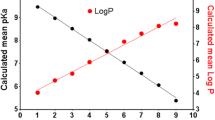Abstract
Adult rhesus monkeys were given a single dose of 1.5 or 3.0 g of a polychlorinated biphenyl (PCB) (Arochlor 1248) per kg body weight and sacrificed four days later. In addition, one monkey from each group was placed in a metabolism cage and the excreta collected during a two-week period and analyzed for PCB content. Over 90 percent of the single PCB dosage was absorbed from the gastrointestinal tract and deposited in various tissues of the body. Elimination of the PCBs, primarily through the biliary system, occurred at a slow rate. The monkeys did not become obviously ill following ingestion of the PCBs, but developed moderate hepatic enlargement due primarily to an increase in lipid droplets and proliferation of the endoplasmic reticulum of the hepatic cells. Gastric hypertrophy and hyperplasia and focal ulceration of the stomach lining were prominent lesions in these animals.
Similar content being viewed by others
References
Albro, P. W., and L. Fishbein: Intestinal absorption of polychlorinated biphenyls in rats. Bull. Environ. Contamin. Toxicol.8, 26 (1972).
Allen, J. R., and L. J. Abrahamson: Enzymatic changes in the liver of rats fed polychlorinated biphenyls, triphenyls, and DDT. Proc. Amer. Chem. Soc., Div. Water, Air, and Waste Chem.12, 97 (1972).
Allen, J. R., L. J. Abrahamson, and D. H. Norback: Biological effects of chlorinated biphenyls and triphenyls on the subhuman primate. Environ. Res.6, 344 (1973).
Armed Forces Institute of Pathology, Manual of Histologic and Special Staining Techniques. New York, McGraw-Hill (1960).
Beckman Model R-101 Microzone Electrophoresis Cell Instruction Manual RM-1M-3, (1965).
Bohoun, C., J. C. Delarue, and E. Comoy: Direct method for the determination of urea in blood with diacetyl monoxime. Clin. Chim. Acta18, 417 (1968).
Caulfield, J. B.: Effects of varying the vehicle for OsO4 in tissue fixation. J. Biophys. Biochem. Cytol.3, 827 (1957).
Curley, A., V. W. Burse, M. E. Grim, R. W. Jennings, and R. E. Linder: Polychlorinated biphenyls: Distribution and storage in body fluids and tissues of Sherman rats. Environ. Res.4, 481 (1971).
Grant, D. L., W. E. J. Phillips, and D. C. Villeneuve: Metabolism of a polychlorinated biphenyl (Aroclor 1254) mixture in the rat. Bull. Environ. Contamin. Toxicol.6, 102 (1971).
Holmes, D. C., J. H. Simmons, and J. O'G. Patton: Chlorinated hydrocarbons in British wildlife. Nature216, 227 (1967).
Jennings, R. W.: Biological sample clean-up for chlorinated hydrocarbon and organophosphorus analysis using electron-capture gas-liquid chromatography. Paper presented at Am. Chem. Soc. Meeting, Atlantic City, New Jersey (1968).
Jensen, S., A. G. Johnels, M. Olsson, and G. Otterlind: DDT and PCB in marine animals from Swedish waters. Nature224, 247 (1969).
Keplinger, M. L., O. E. Fancher, and J. C. Calandra: Toxicological studies with chlorinated biphenyls. Proceedings NIEHS Polychlorinated Biphenyl Conference, Research Triangle Park, N. C., Dec. 20–21 (1971).
Koeman, J. H., A. A. G. Oskamp, J. Veen, E. Brouwer, J. Rooth, P. Zwart, E. V. D. Broek, and H. Van Genderen: Insecticides as a factor in the mortality of the sandwich tern (Sterna sandvicensis). Meded. Rijksfac. Landbouwwetenschappen Gent.32, 841 (1967).
Koeman, J. H., M. C. Ten Noever De Brauw, and R. H. De Vos: Chlorinated biphenyls in fish, mussels, and birds from the River Rhine and the Netherlands coastal area. Nature221, 1126 (1969).
Kuratsune, M.: An epidemiologic study on “Yusho” or chlorobiphenyls poisoning. Fukuoka Acta Medica60, 513 (1969).
Kuratsune, M., T. Yoshimura, J. Matsuzaka, and A. Yamaguchi: Epidemiologic study on Yusho, a poisoning caused by ingestion of rice oil contaminated with a commercial brand of polychlorinated biphenyls. Environ. Health Persp.1, 119 (1972).
Lowry, O. H., N. J. Rosebrough, A. L. Farr, and R. J. Randall: Protein measurement with Folin phenol reagent. J. Biol. Chem.193, 265 (1951).
Mollenhauer, H. H.: Plastic embedding mixture for use in electron microscopy. Stain Tech.39, 111 (1964).
Munro, H. M., and A. J. Fleck: The determination of nucleic acids. Methods of Biochem. Anal.14, 113 (1966).
Norback, D. H., and J. R. Allen: Enzymatic and morphologic alterations of hepatic endoplasmic reticulum induced by chlorinated aromatic hydrocarbons. Fed. Proc.29, 816 (1970).
Norback, D. H., and J. R. Allen: Chlorinated triphenyl induced extension of the hepatic endoplasmic reticulum. Proc. Soc. Exp. Biol. Med.139, 1127 (1972).
Reitman, S., and S. Frankel: A colorimetric method for the determination of serum glutamic oxalacetic and glutamic pyruvic transaminases. Am. J. Clin. Path.28, 56 (1957).
Vos, J. G.: Toxicology of the PCBs for mammals and birds, Environ. Health Persp.1, 105 (1972).
Vos, J. G., and J. H. Koeman: Comparative toxicologic study with polychlorinated biphenyl in chickens with special reference to porphyria, edema formation, liver necrosis, and tissue residues. Toxicol. Appl. Pharmacol.17, 656 (1970).
Vos, J. G., and T. De Roij: Immunosuppressive activity of a polychlorinated biphenyl preparation on the humoral immune response in guinea pigs. Toxicol. Appl. Pharmacol.21, 549 (1972).
Werchselbaum, T. E.: An accurate and rapid method for the determination of proteins in small amounts of blood serum and plasma. Am. J. Clin. Path.28, 56 (1946).
Author information
Authors and Affiliations
Additional information
This investigation was supported in part by U.S. Public Health Service grants ES-00472 and RR-00167, and the University of Wisconsin Sea Grant. Primate Center Publication No. 13-029.
Rights and permissions
About this article
Cite this article
Allen, J.R., Norback, D.H. & Hsu, I.C. Tissue modifications in monkeys as related to absorption, distribution, and excretion of polychlorinated biphenyls. Arch. Environ. Contam. Toxicol. 2, 86–95 (1974). https://doi.org/10.1007/BF01985803
Received:
Accepted:
Issue Date:
DOI: https://doi.org/10.1007/BF01985803




